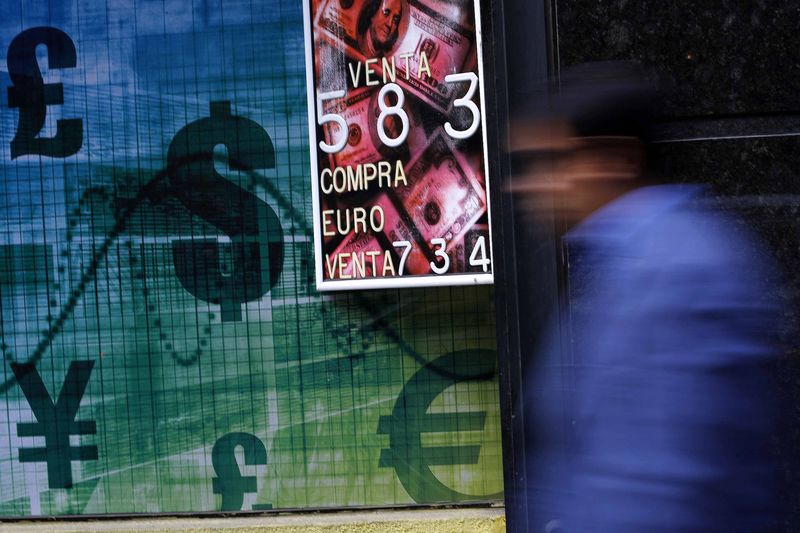* Dollar index edges down but on track for solid weekly gain
* Market focus shifts back to Fed hike risk from Greece
* Greek worries fade as Europe moves to reopen funding
* Commodity currencies rue tough week
By Lisa Twaronite and Ian Chua
TOKYO/SYDNEY, July 17 (Reuters) - The dollar edged away from two-month highs against a basket of major currencies on Friday but was still on track for a solid weekly gain as the market shifted its focus to an eventual hike in U.S. interest rates.
The dollar index was up about 1.5 percent in a week in which Federal Reserve Chair Janet Yellen reiterated that the U.S. central bank would likely lift interest rates later in the year. ID:nL2N0ZW2MN
The dollar index .DXY stood at 97.496, down about 0.2 percent after having risen as far as 97.756 in the previous session. A break above 97.775 would take the index back to highs last seen in April.
The greenback was down about 0.1 percent on the day against the yen after touching a one-month peak of 124.235 yen JPY= , still on track to gain more than 1 percent for the week.
U.S. economic data was mixed on Thursday. The number of Americans filing new applications for unemployment benefits fell more than expected last week, but factory activity in the U.S. mid-Atlantic region grew at a slower pace than anticipated. ID:nL2N0ZW0OZ ID:nZON02I200
June U.S. inflation data is due later in the day. ECONUS
Yellen repeated on Thursday that the Fed's decision on when to hike rates will remain data-dependent, but some market participants are already looking past the well-signalled rate hike that could come as early as September.
"We've been expecting this hike for so long that by the time they do it, there's really a huge risk that this is going to be a classic 'buy the rumour, sell the fact' type of result," said Bart Wakabayashi, head of foreign exchange for State Street Global Markets in Tokyo.
The euro added about 0.2 percent to $1.0897 EUR= , not far off a 7-1/2 week low of $1.0855 set overnight but still down more than 2 percent in a week marred by fears that Greece was on the brink of a financial crisis that would take it out of the euro zone.
Concerns about Greece's exit from the common currency eased after European creditors moved cautiously towards reopening funding to Greece's stricken economy on Thursday. ID:nL5N0ZW0VG
Bank of England Governor Mark Carney also drew the market focus back onto global interest rates just as worries about Greece were fading. ID:nL5N0ZW0VG
On Thursday, Carney said the decision to lift British interest rates from record lows will come into sharper focus around the end of this year. Earlier in the week, he said the time for a hike was moving closer. ID:nL5N0ZW4SI
Sterling raced to a 7-1/2 year high on the euro, which skidded to 69.58 pence EURGBP=R on Thursday and was last up about 0.1 percent at 69.68 pence. Against the dollar, the pound stood at $1.5625 GBP=D4 , up about 0.2 percent on the day and moving back toward a two-week peak of $1.5676 scaled on Wednesday.
COMMODITY CURRENCIES UNDER PRESSURE
While investors warmed to the dollar and sterling this week, the Canadian, Australian and New Zealand dollars all slumped to six-year lows as weakness in commodity prices crimped growth prospects in their respective economies.
Underscoring the bleak outlook, the Bank of Canada cut interest rates for a second time this year on Wednesday. ID:nL2N0ZV11H
The Reserve Bank of New Zealand is considered almost certain to lower rates next week, while Australia's central bank is still seen keeping an easing bias for now. ID:nL4N0ZV27P
The Canadian dollar last traded at C$1.2954 per USD CAD=D4 , flat on the day and not far from a trough of C$1.2974 set earlier in the session. The kiwi dollar dipped below 65 U.S. cents NZD=D4 for the first time since July 2009 on Thursday, before steadying at $0.6537.
The Australian dollar stood at $0.7412 AUD=D4 , up about 0.1 percent from Thursday, when it skidded as low as $0.7350, a low not seen since mid-2009. (Editing by Shri Navaratnam and Richard Borsuk)
